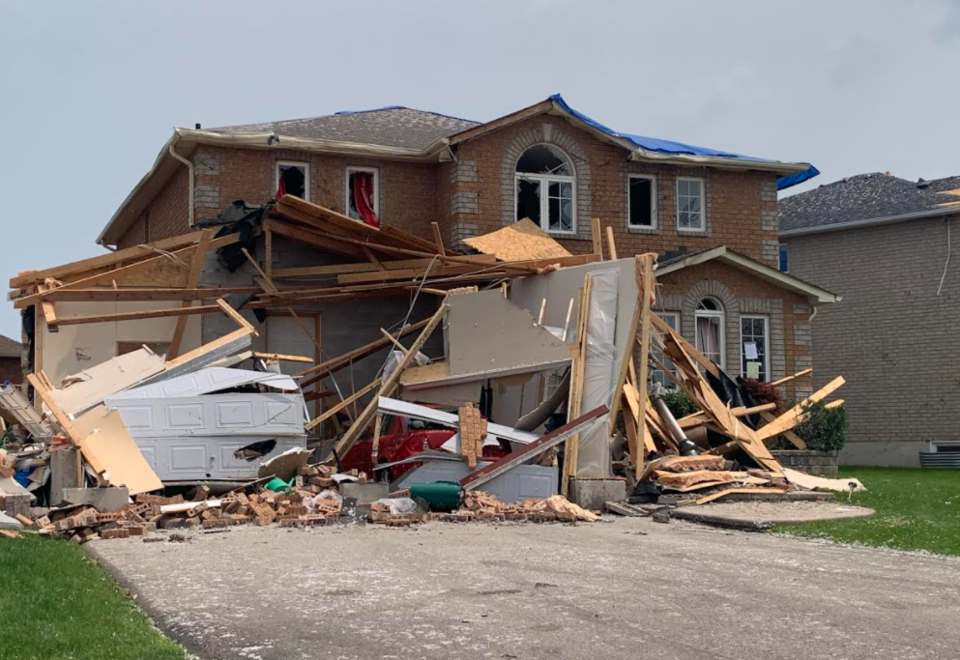BARRIE -- Reconstruction and the speed of how a south-end Barrie neighbourhood is recovering following last summer’s tornado will be the focus of a team returning to the city one year later.
Greg Kopp, co-lead on the Northern Tornadoes Project based at Western University in London, Ont., arrived on the tornado scene last July 15, four hours after much of a southeast neighbourhood was torn apart. He and his team were keen to examine the damage before it was disturbed as cleanup efforts commenced.
Just after 2 p.m. that day, a super cell developed from storms southwest of Barrie and then travelled roughly along Mapleview Drive, crossing over Highway 400 and heading east-northeast.
The resulting tornado tore through a largely residential neighbourhood in south-end Barrie at about 2:30 p.m., damaging homes, flipping and pushing vehicles into each other as well as into houses, and toppling trees. Ten people were injured.
With the help of drone imagery, the tornado’s maximum wind speed was estimated to be 210 kilometres per hour, making it a high EF-2 tornado. The tornado tracked 12.5 kms through the city’s south end and had a maximum width of 510 metres.
It was later determined that there were 10 tornadoes in Ontario that day — seven rated as EF-2 — resulting in a total of 14 injuries.
Now, a year later, Kopp is returning to Barrie to document the progress of the rebuilding efforts.
Kopp is part of a pilot project to determine how fast recovery can happen. He is partnering with Jennifer Spinney, an environmental anthropologist in York University's disaster and emergency management program, who describes her work as being at the intersections environment and society.
“We want to examine actually what’s happening in Barrie in terms of recovery,” Kopp said. “We’re going to try to follow, over the next few years, how the recovery occurs.
“Ultimately, what we would like to be able to do with this kind of work is make better recommendations on how recovery can happen. What are the processes, what are the barriers to it," he added.
According to officials at Barrie City Hall, 70 unsafe orders were issued on local homes impacted by the tornado, with all but three lifted.
As of last week, 56 building permits had been issued along with nine demolition permits. One building permit remains outstanding as city building officials await more information before it is issued.
Kopp said when he and his engineering team return on Friday, they’ll examine the progress of the recovery with the help of a drone flying over neighbourhoods that experienced the worst damage.
Only once before had Ontario recorded an outbreak of this magnitude with at least seven EF-2-plus tornadoes occurring in one day, according to the Northern Tornadoes Project.
It also focused its wrath on Barrie.
On May 31, 1985, one of a series of mighty F4 tornadoes ripped through the main street in Grand Valley, skipping across central Ontario and tracking a path though Barrie roughly parallel to last summer’s tornado. It, too, crossed Highway 400, but a little farther north at Essa Road, tearing a damaging path right into an Allandale residential area. There were 12 deaths, including eight in Barrie, that day and 224 injuries.
There have been many advances and new developments in the intervening 36 years.
But on the building front, Kopp thinks we can do better. Following last summer’s tornado he suggested that hurricane straps, costing a few hundred dollars per house, may have made the difference for some of the homes that lost their roofs, sparking some intense discussions in Barrie and in other communities.
Kopp's project to examine how a community recovers will consider more than just the buildings. With Spinney looking at the social dimension, the two plan to collaborate, combining her area of social science with Kopp’s engineering expertise in building science.
“We want to develop some community informed guidelines, some practical strategies and tips for how communities can build their capacity to rebuild from these events,” Spinney told BarrieToday.
The hope is to enhance resilience so communities can prepare for and respond when impacted by tornado disasters.
Spinney said she wants to know how stakeholder groups experience recovery, how other life factors influence recovery outcomes for both residents and commercial property owners and how resilience influences tornado recovery. That involves residential and commercial property owners, insurance groups and others that became involved to create a shared understanding.
“Findings from this study will contribute to an event database and will generate recommendations that can be considered by individuals, communities and organizational stakeholders,” she explained.
The plan is to have a report done by the fall of 2023.
Spinney had a chance to examine recovery efforts following the 2018 Dunrobin tornado in the Ottawa area. That project is still ongoing and she expects analysis to be complete by the end of the summer.
Recovery, and ultimately how to mitigate all that damage, is a goal, Kopp said.
“That’s something we really care about,” he explained.
Barrie has been active in looking at how to prevent damage in the future by examining how homes can be made safer to withstand more extreme weather events, Kopp added.
After visiting Barrie, the goal of the team is to include the post-examination approach more systematically in follow-up work when urban areas have significant damage.
“Barrie’s been very active in trying to mitigate this thing, so I’ve been impressed that the city has worked with its chief building official,” said Kopp, adding that they’ve made recommendations to the province to improve building codes.
“As an engineer… one of the things we want to do is mitigate the damage from these storms, reduce the losses,” he noted. “It’s really hard to get back to normal. So the less damage these storms cause, the better.”
--BarrieToday.com
